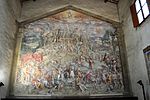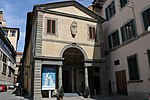San Giovanni Decollato, Pistoia
12th-century Roman Catholic church buildings in ItalyRoman Catholic churches in Pistoia
San Giovanni Decollato is a Roman Catholic parish church located on Via Memoreto and Via San Pietro in Pistoia, region of Tuscany, Italy. At the other end of Via Memoreto is the Romanesque church of Santa Maria Nuova, and to the left the Oratory of San Desiderio.
Excerpt from the Wikipedia article San Giovanni Decollato, Pistoia (License: CC BY-SA 3.0, Authors).San Giovanni Decollato, Pistoia
Via Nemoreto, Pistoia
Geographical coordinates (GPS) Address Nearby Places Show on map
Geographical coordinates (GPS)
| Latitude | Longitude |
|---|---|
| N 43.931671 ° | E 10.921133 ° |
Address
San Giovanni Decollato (San Giovanni Battista al Tempio)
Via Nemoreto
51100 Pistoia
Tuscany, Italy
Open on Google Maps










